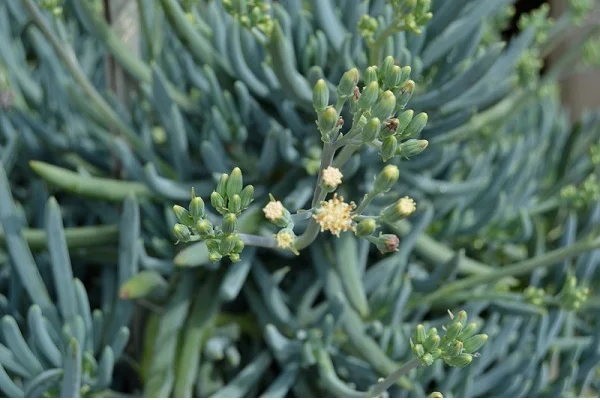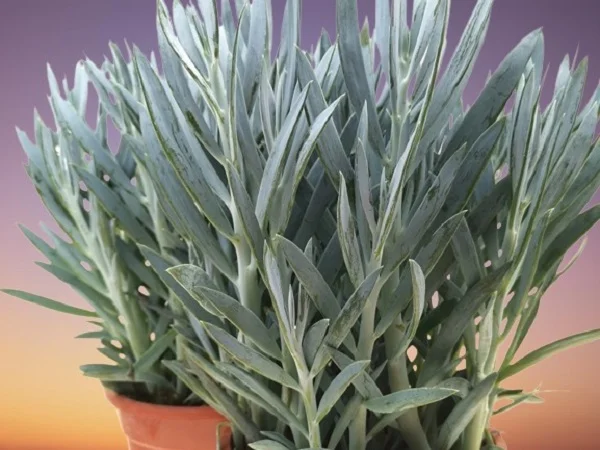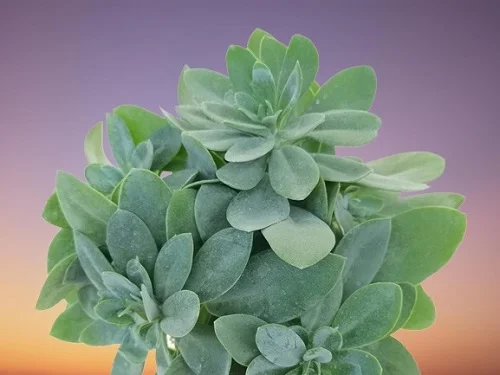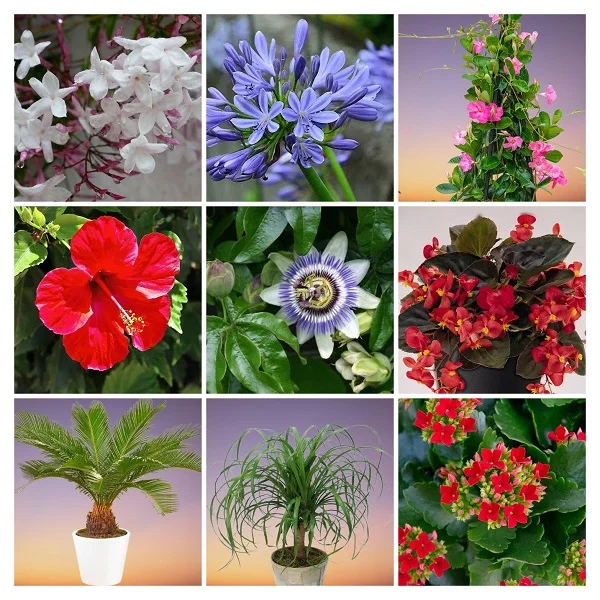Senecio serpens - Blue Chalksticks Plant (Curio repens) Indoor Care, Propagation, Problems
Some links in this post may be affiliate links
Blue Chalksticks Plant (Senecio serpens) requires bright light with some direct sunlight, warm temperatures, moderate humidity and moderately moist, loose, rich, well-drained, succulents soil coupled with monthly feeding in the growing season.
Senecio serpens (Curio repens) also called Dead Man's Fingers is one of the low-growing Senecio varieties with fleshy, cylindrical, powdery, blue-green leaves on stems which start off erect then lie prostrate and root at the nodes as they grow.
Blue Chalksticks Plant's odd shaped leaves is an adaptation to arid conditions and allows for the storage of water while exposing minimum surface area to the dry air.
This greatly reduces water loss as the fleshy leaves and stems store water, which allows the Dead Man's Fingers Plant to go for a considerably long period without being watered. This places this plant among the drought-tolerant plants for the home.
On account of its requirement for very bright light with exposure to some direct sunshine, Blue Chalksticks Plant is one of the best succulent plants for a sunny location in the home.

Botanical name: Senecio serpens
Synonmy: Curio repens, Senecio repens
Family: Asteraceae
Common names: Blue Chalksticks Plant, Dead Man's Fingers
Origin
Senecio serpens also called Senecio repens is a perennial, succulent plant native to the Western Cape Province of South Africa where it is found growing from crevices in the rocky sandstone slopes.
The Senecio serpens has been reclassified as Curio repens. The genus name, 'repens' means creeping which is in reference to the creeping growth habit of the plant.
Size
Blue Chalksticks Plant grows to a height of 1 feet by 2-3 feet wide. The finger-like leaves are about 1-2 inches long.
Toxicity
Blue Chalksticks Plant like other Senecio species is toxic to humans and pets as outlined by ASPCA. They contain Pyrrolizidine alkaloids which if is ingested, can cause drooling, vomiting, diarrhea and lethargy. Contact with the plant sap may cause skin irritation or skin rash in sensitive skin therefore, always wear gloves when handling the plant.< Keep the plant away from the reach of children and pets to avoid mishaps.
Where to Buy
Are you looking to add Blue Chalksticks Plants to your collection? They are available online on Etsy (Link to Etsy).
Curio repens Care Indoors
Blue Chalksticks Plant (Senecio serpens) requires bright light with 4-6 hours of direct sunlight, average warmth of 20-270C, humidity of 50-55% and moderately moist, loose, fertile, well-drained, succulents soil coupled with monthly feeding during the growing season.
Curio repens requires pruning to keep the plant neat and to reduce pest and disease infestations. Repotting is only needed when the plant has become root-bound. Keep reading for more on these growing conditions and how to achieve them.

Light Requirements
Blue Chalksticks Plant grows best in bright light with at least 4-6 hours of morning or late afternoon sunlight. Keep it away from hot midday sunshine to avoid scorching the leaves.
You may also grow the plant under grow lights where the natural light is not sufficient. Take a look at these full spectrum grow lights available on Amazon.
Regularly turn the pot to ensure that the plant receives light on all sides for uniform growth as well as prevent lopsided growth.
Watering
Water Blue Chalksticks Plant liberally during the growing season while allowing the top 2-3 inches of soil to dry out between waterings to maintain the soil moderately moist.
Decrease watering in the cold period to maintain the soil barely moist but do not allow the soil to dry out completely as it can lead to wilting and leaf drop.
Confirm that the pot has a drainage hole inorder to prevent the soil from getting soggy as it can lead in rotting and death of the plant.
Temperature and Humidity
Average warmth of 20-270C is ideal for Blue Chalksticks Plant. A room temperature that is comfortable for you is ideal for this plant. Keep it away from drafts as it does not like sudden changes in the temperature.
Dead Man's Fingers Plant has no need for extra humidity. Average room humidity of 50-55% is ideal for this plant. Ensure that there is good air circulation to prevent fungal diseases infestations.
Potting Mix
The best soil for Blue Chalksticks Plant should be rich in organic matter, loose and free-draining to avoid getting soggy soil. The soil should be loose enough to allow water to drain out fast enough. Cactus and succulents mixes are ideal as they drain easily.
Feeding
Feed Blue Chalksticks Plant monthly during the growing season with a balanced, liquid fertilizer. This plant is not a heavy feeder so be careful when feeding.
Stop feeding in the cold season as growth is minimal at this time and feeding at this time can cause fertilizer burn and eventual death of the plant.
Repotting
Blue Chalksticks Plant has a small root system so frequent repotting is not necessary. Repot it at the beginning of the growing season only when it becomes crowded in its current pot.
Use a pot that is only 1 size larger than the current one and one that has a drainage hole to prevent the soil from getting soggy as it can lead to rotting. Use a shallow pot as the root system is tiny and be careful not to bury the stems to prevent rotting. Check out these succulents pots on Amazon.
Pruning
Pruning Blue Chalksticks Plant involves removal of any dead flowers, leaves and stems to keep the plant neat and also reduce pest and disease infestations.
Propagation
Senecio serpens (Curio repens) can be propagated at the beginning of the growing season from leaf and stem cuttings or by plant division.
1. How to propagate Blue Chalksticks Plant from leaf cuttings
Take leaf cuttings from a healthy Blue Chalksticks Plant and ensure each leaf cutting is whole.
Allow some time for the formation of a protective callus tissue over the cuts of the leaf cuttings to prevent rotting.
Insert 1.5 in. the leaf cuttings in moist, cactus and succulents mix and lightly firm the soil around the cutting.
Place the set up in a warm, well-lit place and maintain the soil moist until plantlets form at the base of the cuttings. Allow enough time for substantial growth of the roots and new leaves.
Transfer the rooted cuttings to individual pots and water the soil thoroughly until water comes out through the drainage holes.
For a fuller plant, transfer several plantlets into one pot.
Position the pots in warm place where it can receive bright light but away from direct sunlight.
Maintain the soil moist until the new Curio repens are well established after which you can begin routine care.
2. How to propagate Blue Chalksticks Plant from stem cuttings
Take 3-5 inches stem cuttings from a healthy Blue Chalksticks Plant and allow the cuttings to dry (callus) for about 2-3 days.
Insert, 2-3 inches of the stem cuttings in moist, cactus and succulents soil and lightly press the soil around the cuttings.
Place the set up in a warm, well-lit place and maintain the soil moist until the stems are rooted.
Allow substancial growth before transplanting the new Curio repens after which you can begin routine care. For a fuller plant, transplant several cuttings into one pot.
3. How to propagate Blue Chalksticks Plant by plant division
Water the Blue Chalksticks Plant thoroughly at least 1 day before to make it easier to divide and also hasten establishment. A well hydrated plant suffers less shock and takes a shorter time to take root.
Take out the plant from its pot and carefully divide it into sections by pulling apart the roots.
Ensure each section has adequate roots to hasten establishment.
Select a 6 or 8 inches pot and ensure that the pot has a drainage hole to prevent the soil from getting soggy as it can lead to rotting.
Fill the pot with cactus and succulents potting mix and make a hole in the center of the pot. Ensure that the hole is slightly wider than the root base of the section.
Place the section in the previously made hole and lightly firm the soil around the base while taking care not to bury it too deep; maintain the section at the same soil level it was in the previous pot.
Water the soil thoroughly and place the set up in a well-lit, warm place until the new Senecio serpens is well established after which you can begin routine care.

Senecio serpens Problems
Blue Chalksticks Plant (Senecio serpens) growing problems include leaf drop, leggy growth, leaf spots, rotting, plant death, pests and diseases among others. Keep reading for more on these problems and how to fix them.
Pests
The common pests in Blue Chalksticks Plant are spider mites, scale insects and mealy bugs. Isolate the affected plant to prevent spread to other plants and treat it for the pests. Learn how to identify and get rid of pests in houseplants.
Diseases
The other common disease in Blue Chalksticks Plant is powdery mildew. Isolate the affected plant to prevent spread to other plants and treat it for the disease.
Brown, soft leaf spots
Brown, soft leaf spots in Blue Chalksticks Plant are an indication of leaf spot disease. Avoid wetting the leaves and improve air circulation to prevent disease infestations.
Leggy stems (elongated stems)
Leggy stems (elongated stems) in Blue Chalksticks Plant during the cold season is due to too much water (overwatering) or soggy soil. Water less during the cold season to maintain the soil barely moist and ensure that the pot has a drainage hole to prevent the soil from getting soggy.
If leggy growth (elongated stems) in Blue Chalksticks Plant happens during the growing season, then the cause is too little light. Move the plant to a brighter spot and ensure it receives bright light with 4-6 hours of direct sunlight or instal a grow light if the natural light is inadequate.
In addition, rotate the pot regularly to ensure that the plant receives light on all sides for even growth. Check out this post on understanding light for houseplants.
Brown dry spots
Brown dry spots in Blue Chalksticks Plant are due to underwatering resulting in too little moisture in the soil. Water the plant moderately during the hot season while while allowing the top 2-3 inches of the soil to dry out between waterings. Significantly decrease watering in the cold period to maintain the soil barely moist as growth is reduced at this time. Learn more on how to water houseplants the correct way.
Sudden leaf drop
There are two possible causes on sudden leaf drop in Blue Chalksticks Plant. One possible cause of sudden leaf drop is watering with very cold water. Being a tropical plant where temperatures are warm, watering with too cold water will shock the plant. Water the plant with water that is at room temperature to avoid shocking this tropical plant.
The second possible cause of sudden leaf drop in Blue Chalksticks Plant is underwatering. Water the plant moderately and allow the soil to dry out but never allow the soil ball to dry out completely.
Rotting base and stem collapse
Rotting plant base and stems collapse in Blue Chalksticks Plant is an indication of basal stem rot disease which is brought about by overwet conditions. Use the upper healthy stems to propagate new plants and discard the infected parts to reduce spread to the rest of the plant.
Thereafter, water the plant liberally during the growing season while allowing the top 2-3 inches of the soil to dry out between waterings. Significantly reduce watering during the cold season to maintain the soil barely moist as growth is minimal at this time.
Wilted and discolored leaves
Wilted and discolored leaves in Blue Chalksticks Plant are caused by overwatering during the cold period. Reduce watering during the cold season and maintain the soil barely moist.
You liked it? Share on social media.
Related Content
Amazon Associates Disclosure
Homeplantsguide.com is a participant in the Amazon Services LLC Associates Program, an affiliate advertising program designed to provide a means for sites to earn advertising fees by advertising and linking to amazon.com.





